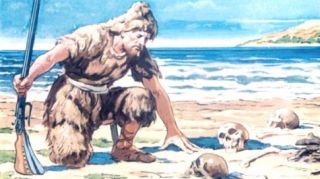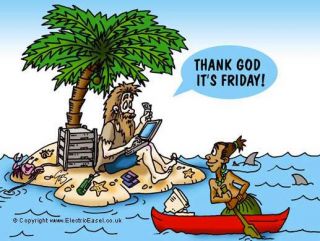Psychology
Robinson Crusoe, Psychologist
The great islander emotes and acts in human—all-too-human—ways.
Posted January 31, 2014

Daniel Defoe published Robinson Crusoe in 1719. The work ranks as the first novel in the English language, and it has stood the test of time. It is a great piece of literary art. Why should we read Crusoe today? To savor the adventure? To enjoy the feeling of recognition when the novel evokes scenes from the movies we have seen? To make up for our failure to read Cervantes? All these are valid reasons. Another one is to contemplate psychology. Great works of literature get into psychological questions. What was Crusoe/Defoe grappling with?
At first glance, Crusoe is about the pragmatics of survival. In his diary, he tells us all about carpentry, hunting, animal husbandry, planting, harvesting, and the processing of food. We learn about his struggles to master these survival skills. He prevails in almost all projects he entertains, and even contemplates impossible ones, like brewing beer without hops or yeast. The mastery narrative reads like a technical manual, much like Moby Dick reads like a manual for whaling – mostly.
Then, Crusoe is also about coping with solitude. We witness the psychological stages of loss, despair, adjustment, and (social) resurrection. His isolation on the island is the defining feature of the story. He is alone, for over 28 years. How can a human being tolerate such extremity? Crusoe’s main coping mechanisms are keeping busy with his everyday tasks and maintaining a one-sided conversation with the Bible. This works so well that his eventual reintroduction into human society is almost as hard as his expulsion was. Crusoe is terrified when he discovers his cannibal neighbors, and, when an English ship arrives, he worries it might be run by homicidal pirates. But having mastered the challenges of building up the physical conditions for his existence and having overcome the stresses of isolation, Crusoe also shows himself to be a deft handler of his social environment. In all, his story is a record of personal triumph. The final chapters recount Crusoe’s gathering of his estate. He ends up a wealthy gentleman, considering new adventures. This reading suggests that the Crusoe story is a version of the hero’s journey, a universal mythical theme, as described by Joseph Campbell (1953). Gilgamech, Ulysses, Parcifal… and Crusoe… and then you, and me.
If we take a closer look at Crusoe’s pages, we find detailed descriptions of a man’s psychological life. I highlight a couple of themes that caught my attention. Mostly, I let the man speak for himself, but comment where I must. The page numbers for the quotes refer to the Dover Thrift Edition.
“I frequently sat down to my meat with thankfulness, and admir’d the hand of God’s providence, which had thus spread my table in the wilderness. I learn’d to look more upon the bright side of my condition, and less upon the dark side, and to consider what I enjoy’d, rather than what I wanted; and this gave me sometimes such secret comforts, that I cannot express them; and which I take notice of here, to put those discontented people in mind of it, who cannot enjoy comfortably what God has given them; because they see and covet something that He has not given them. All our discontents about what we want appear’d to me to spring from the want of thankfulness for what we have.” (p. 95)
From the Siddhartha to Seligman, this focusing approach to happiness has been a perennial teaching. A character like Crusoe can give it poignancy. But it is difficult to reach and to teach serenity, so Crusoe adds (somewhat inelegantly) the element of downward social comparison (Wills, 1981).
“It put me upon reflecting how little repining there would be among mankind at any condition of life, if people would rather compare their condition with those that are worse, in order to be thankful, than be always comparing them with those which are better, to assist their murmurings and complainings.” (p. 122; see also Russell, 1930)
Once he discovered how to be cheerful by focusing on the positive, he realized that his evaluations of what is negative were also flexible.
He observed, “how frequently, in the course of our lives, the evil which in it self we seek most to shun, and which when we are fallen into it is the most dreadful to us, is oftentimes the very means or door of our deliverance, by which alone we can be rais’d again from the affliction we are fallen into.” (p. 132)
To the selective focus of the positive, the re-evaluation of the negative (who knows what it is good for in the long run?), he adds his appreciation for the narrowness of consciousness, which protects us from the dread of the world.
“This furnish’d my thoughts with very many profitable reflections, and particularly this one, how infinitely good that providence is, which has provided in its government of mankind such narrow bounds to his sight and knowledge of things; and though he walks in the midst of so many thousand dangers, the sight of which, if discover’d to him, would distract his mind and sink his spirits, he is kept serene and calm, by having the events of things hid from his eyes and knowing nothing of the dangers which surround him.” (p. 143)
Man’s ignorance of his future also keeps him from seeing the good that is coming. For this Crusoe also offers an optimistic interpretation.
Sometimes men “are nearer their deliverance than they imagine; nay, are even brought to their deliverance by the means by which they seem to be brought to their destruction.” (p. 185)
Crusoe wisely includes the word “sometimes” as he is well aware that all his shipmates drowned, thereby being rendered unable to expect or experience deliverance. By necessity, Crusoe’s memoir is a survivor’s story.
Crusoe knows about fear: of the elements, solitude, wild beasts, cannibals, and pirates, but experience tells him that
“Fear of danger is ten thousand times more terrifying than danger it self.” (p. 116)
When the cannibals land on the island, Crusoe must look beyond his own emotional state and come to a decision about what to do. Here, Defoe lets us in on a man’s struggle to find a response to a moral dilemma, a struggle that begins with Crusoe’s effort to understand and define the dilemma.
When the ‘savages’ come ashore, Crusoe has a choice between hiding and hoping to go unnoticed, and attack. If he attacks, he needs to kill them all so that the survivors won’t return with reinforcements. He also figures that if he saves a prospective victim of cannibalism, he can turn him (Friday) into a companion and assistant in a quest to leave the island. Each alternative is risky. If Crusoe hides, he might be discovered. If he goes on the attack, he might fail to kill all. Crusoe struggles with this dilemma for years, thus making it a case of sequential decision-making. By hiding, he is essentially choosing inaction. He eventually changes his mind and goes on the attack when the savages land on a beach closer to his hide-out. In other words, he switches to action when inaction becomes riskier. By this analysis, Crusoe is being rational. He weighs his options in the light of self-interest and he responds to changes in the probability of the outcomes. This type of rational decision analysis is amoral (not immoral); it is unaffected by moral considerations.
Yet, as a complete human being, Crusoe struggles mightily with the moral dimension of his dilemma.
He describes his emotional seesaw, “the frights and terrors I was in about the savages… I could think of nothing but how I might destroy some of these monsters in their cruel bloody entertainment, and, if possible, save the victim they should bring hither to destroy… I made no doubt that but if there was twenty I should kill them all. This fancy pleas’d my thoughts for some weeks.” (p. 123)
Then moral qualms present themselves. “How do I know what God Himself judges in this particular case? It is certain that these people either do not commit this as a crime; it is not against their own consciences reproving, or their light reproaching them. They do not know it be an offence, and then commit it in defiance of divine justice, as we do in almost all the sins we commit. They think it no more a crime to kill a captive taken in war, than we do to kill an ox; not to eat human flesh, than we do to eat mutton. When I had consider’t this a little, it follow’d necessarily that I was certainly in the wrong in it.” (p. 125)
After this impressive exercise in perspective-taking, Crusoe wonders whether the risk of being caught by the cannibals can justify a pre-emptive attack, and, for the moment, his answer is no. “These people had done me no injury… and therefore it could not be just for me to fall upon them. That this would justify the conduct of the Spaniards in all their barbarities practis’d in America.” (p. 125) This is a remarkable twist. Crusoe is not content to decide against attack simply on the notion that he himself was not attacked first; he considers the symbolic implications of a pre-emptive attack, arguing that it would morally justify a much greater evil. This consideration is almost Kantian. Crusoe will not attack because such a deed could not be set up as a general rule. Strangely, he overlooks a critical difference. The cannibals pose a real threat to his life, but no threat to the existence of the Spanish empire.
Crusoe then returns to the risk of being discovered and killed, and concludes that doing nothing “was the way not to deliver my self, but entirely to ruin and destroy my self; for unless I was sure to kill every one that not only should be on shore at that time, but that ever should come on shore afterwards, if but one of them escap’d to tell their country people that what happen’d they would come over again by thousands to revenge the death of their fellows, and I should only bring upon my self a certain destruction.” (p. 126)
Having decided in the favor of self-interest, Crusoe shelves the question of his moral responsibility to assume the role of judge. “As to the crimes they were guilty of towards one another, I had nothing to do with them; they were national, and I ought to leave them to the justice of God, who is the governour of nations.” (p. 126)

So he proceeds and finds Friday.
Years later, Crusoe faces the same dilemma again. The cannibals have landed even closer to his hide-out, and Crusoe feels “my former thoughts returning… it occur’d to my thoughts, what call, what occasion, much less what necessity I was in to go and dip my hands in blood, to attack people who had neither done, or intended me any wrong, who as to me were innocent, and whose barbarous customs were their own disaster, being in them a token indeed of God’s having left them, with the other nations of that part of the world, to such stupidity, and to such inhumane courses [so that] He would take the cause into his own hands… but that in the mean time it was none of my business.” (p. 170)
Again, Crusoe declines to be the moral judge, which returns him to the task of making a decision in his (and Friday’s) best interest. This time, he does not merely assume that the threat of being discovered is too great to be tolerated – as he had done before – instead he decides that the course of events should decide for him. He simply prepares for attack and sets an ambush. “I resolv’d I would only go and place my self near them, that I might observe their barbarous feast, and that I would act then as God should direct, but that unless something offer’d that was more a call to me than yet I knew of, I would not meddle with them.” (p. 170).
On the one hand, this approach to decision-making is very different from his earlier one. Before, Crusoe chose action after a careful weighing of risks and outcomes. Now, he only sets the stage for a stimulus for action to present itself, while leaving it open what this stimulus might be (“than yet I knew of”). Soon enough, the stimulus appears. Friday reports that one of the cannibals’ captives is a bearded white man, whereupon Crusoe “with-held my passion, though I was indeed enrag’d to the highest degree.” The decision was made. “I had now not a moment to lose.” (p. 171)
It is difficult to evaluate this decision mode without explicit criteria for what would make a stimulus sufficient for action or without knowing Crusoe’s implicit standards. It is even possible that the decision mode, as described, is deceptive and perhaps self-deceptive, that the resolution for action had been made implicitly, and that any stimulus would be deemed a sufficient rationalization once it appeared. Barring this possibility, Crusoe is being consistent in that he had earlier expressed the view that moral intervention is justified within nations. Now that the life of a fellow European and Christian was at stake, Crusoe had sufficient reason.
Overall, this reading of Crusoe suggests that his actions unfold with a strict internal logic, and that much of his emotional upheaval and moral scrupling is an unfortunate waste – as he himself recognizes. As Crusoe lives and enacts the arc of his adventure by responding to necessity, we can see him as an example Campbell’s monomyth or as a character out of a Greek tragedy. He does what he has to do. He could do no other.
Note. I thank Rosamel Benavides-Garb and Russell Gaskell for stimulating discussions about Crusoe. Russell made the connection between Crusoe and Campbell's monomyth.
Campbell, J. (1953). The hero with a thousand faces. New York, NY: Pantheon
Defoe, D. (1998/1791). Robinson Crusoe. Mineola, NY: Dover.
Russell, B. (1930). The conquest of happiness. London, England: Allen and Unwin.
Wills, T. A. (1981). Downward comparison principles in social psychology. Psychological Bulletin, 90, 245-271.




